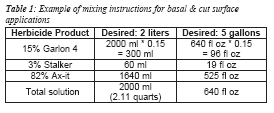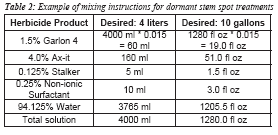
Fall 2009
Volume 18 No. 3
Herbicide Options to Control Woody Invasive Plants
By Zach Lowe, Ph.D. & Matt Kraushar
Results given below are from research conducted on: autumn olive, bush honeysuckle, multiflora rose, black locust, tree-of-heaven (avoid cut surface due to re-sprouting nature), black cherry and sweet gum. However, the recommended herbicide solutions prove to be similarly effective on the majority of species of interest.
When woody invasive plants are few and scattered, or exist in small patches, we have found three treatments that work well: 1)
basal, 2) cut-surface, and 3) dormant stem low-volume (50 GPA) spot treatments. These application types will extend your spray season throughout the dormant season. However, if the invasive woody plants have a high density, tall canopy height, or the occurrence of favorable natives is low, our preferred method is a broadcast foliar application during the growing season.Basal Applications
We define a basal bark treatment as the application of an herbicide solution to the entire circumference and bark surface area of woody plants starting from the root collar extending upward to a height of 18 in (46 cm).
Cut-surface Applications
Cut-surface applications involve the application of an herbicide solution to the cross-sectional cambium layer of the woody stump that is exposed after the main stem(s) and bowl of the plant have been mechanically removed (typical mechanical removal include chainsaw, thinning saw, mowing, and brush shears, stems are typically cut just above the root collar). Herbicide should be applied only to the cambium layer and not to the sides of the stump, root collar, or soil in an effort to minimize the use of herbicide. Cut surface applications should be made as soon after making the cut as possible; delay in application of the herbicide solution may reduce efficacy.
Equipment for Basal and Cut-surface Applications
: A backpack sprayer or any small self-operated application system operating at approximately 20 PSI and outfitted with an adjustable cone nozzle set to spray a single stream can be used. Similarly, for small control jobs, a handheld sprayer will work.Season:
These treatments are intended for the dormant season but can be applied year round. Do not treat stems with rain, ice, or excessive debris. Temperatures should ideally be between 20° and 90° Fahrenheit.Caution:
Spray only to the point of wetting, do not spray to the point of run off with either method. Do not use cut-surface method for control of tree-of-heaven. This will cause extensive sprouting.Recommended application rate:
Based on our data, a solution of 15% Garlon 4 + 3% Stalker + 82% Ax-it basal oil provides 100% mortality for both application methods. Mix for volume of desired total spray solution (see example in Table 1).
Dormant Stem Spot Treatment
This technique relies on a low-volume spot application method with relatively low amounts of herbicide in the spray solution. This spray solution is applied to individual stems and requires covering most of the bark surface area to the point of wetting, not run off. This includes the main stem, branches, and twigs.
Equipment for Dormant Stem Spot Treatments:
A skid sprayer, backpack, or pressurized hand sprayer outfitted with a narrow cone nozzle operated at 35-40 PSI provides an adequate spray pattern.Season:
Apply during the dormant season (late winter to early spring) to reduce risk to non-target species and improve the opportunity for herbicide translocation.Caution:
Spray coverage is essential to the success of this application. This solution requires tank agitation while spraying. Do not spray stems over desirable vegetation that is not dormant, or non-target plant injury may occur.Recommended application rate:
This method produced 100% mortality in our tests. We recommend using the mixture with 0.125% Stalker + 1.5% Garlon 4 + 4% Ax-it + 0.25% nonionic surfactant. It is imperative to provide tank agitation while spraying this solution. This solution should be mixed by volume of desired total spray solution (see example in Table 2).
We present tank mixtures by the percentage of each herbicide in the total volume of solution for ease of mixing procedures. Using these percentages, it is easy to mix up a very small amount for spot treating plants, or a large tank sufficient to treat several acres. Remember to always read and follow any pesticide label. Proper personal protection equipment should always be worn when applying pesticides and operating equipment.
Zach Lowe is an adjunct professor of natural resources with Purdue University’s Department of Forestry and Natural Resources, and national coordinator for Conservation Leaders for Tomorrow. Matt Kraushar is a habitat specialist and graduate assistant in the Department of Forestry and Natural Resources at Purdue University.
Home